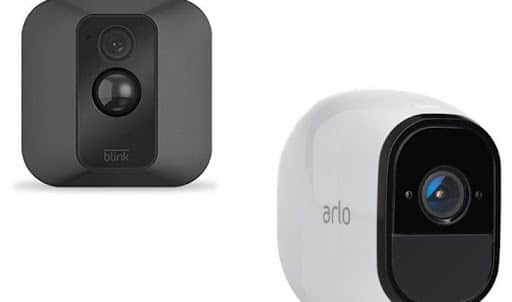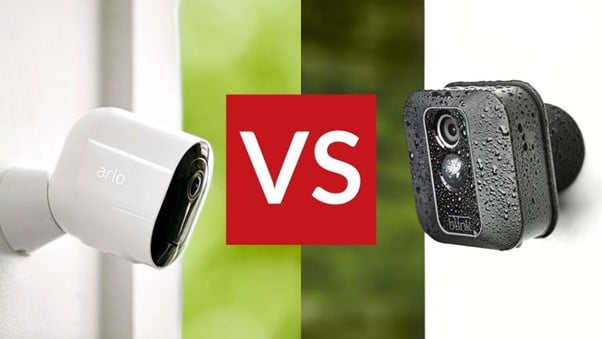With constant technological progress, cameras have become vital to the domain of home security in modern times.
There is a surplus of home security systems in the market. Homeowners have a wide variety of products to choose from. Arlo and Blink are some of the leading brands in the wireless camera industry.
Each offers its own set of unique features while also being like the other in certain aspects. So, which side should you be on in the Arlo VS Blink battle?
In a nutshell, Arlo cameras are equipped with highly advanced technology. This makes the brand quite expensive. However, blink cameras have adequate features for enhancing your home security.
They are much more affordable than their sophisticated counterpart. But there is more to cameras than just their cost. Here is a detailed comparison of the two brands.
No products found.
No products found.
Arlo Vs Blink – Detailed Comparison

As established already, Blink is more pocket-friendly than Arlo. However, pricing is not the only matter of difference.
The two brands differ in terms of their performance as well. Arlo comes with a wide set of specifications and settings. For example, it uses rechargeable batteries and is equipped with a more technologically advanced system.
Blink, on the other hand, has its own advantages. It is entirely wireless and can capture and reproducing high-quality images. You can also connect a Blink camera to your Alexa, thus creating an easy home network.
The following are specific points of difference between Arlo and Blink cameras:
Subscription and Contracts
Home security systems ideally should not need any additional subscription fees. But many companies have such policies.
Fortunately, you do not need to incur extra costs for subscribing to either Arlo or Blink systems. You do not even need to sign any special contract. Arlo does have one optional service that needs an additional subscription, though.
You can opt for a special monthly cloud storage service at an extra fee. But that is completely optional.
Characteristics
You can use Arlo cameras for both indoor and outdoor surveillance. These cameras sync with other devices in the network. Thus, you have access to a fully wireless service. Arlo cameras are also capable of 24*7 functioning.
They can monitor a space day in and day out without compromising on the quality of images. They have a super-sensitive motion detector that captures the smallest of movement in its line of vision. Unfortunately, blink cameras lack 24*7 functionality.
However, their range of vision is about 100 feet. You can sync approximately ten cameras to the network hub. These cameras are also armed with smart motion sensors. There is a limit on the length of video storage. But the quality of the video is quite satisfactory.
Price Structure
Arlo home security system is priced at a minimum of $200. The cost can go up to about $400 as per your requirements.
A single Arlo camera costs nearly $200. You can add these pieces to your system accordingly. Comparatively, the camera system offered by Blink is much cheaper at about $79.99.
You can upgrade the basic system as per your needs. Blink cameras are the way to go if you need decent security on a tight budget.
Starter Pack Equipment
Arlo cameras offer two-way communication. The brand’s starter pack includes two cameras along with the respective wiring cables.
You also get adjustable magnetic brackets in the pack. The Arlo system has a storage capacity of as much as 1000 hours. The video recording time on Blink cameras is limited to a minute.
But they have an in-built microphone and the ability to produce 720p videos. There is no two-way communication on the Blink system, though.
Connectivity Features
It is essential to install a home security system that is convenient and user-friendly. Arlo cameras stand true to this ideal. In addition, you can pair an Arlo camera with the SmartThings hub.
Both Wi-Fi and cellular data work for running the Arlo system. Blink cameras are not as flexible as the Arlo ones. You must have a strong Wi-Fi network to operate the Blink system.
Smart Home Integration
One of the key determinants of a good user experience for a home security system is its capability to integrate with pre-installed smart home services.
The Arlo cameras win this round with more flexibility than the Blink system. You can integrate the Arlo cameras with different smart services such as Google’s Google Assistant, Amazon’s Alexa, Home Kit, SmartThings, and even IFTTT. Blink cameras noticeably fall short in this domain.
No products found.
You can connect the Blink system to only Amazon Alexa or IFTTT. Therefore, the Arlo camera system is wider in its scope. It provides a better user experience in an uncomplicated manner.
Installation and Battery Life
Both Arlo and Blink cameras are designed for simplicity. You do not need any technical expertise to install the cameras on your property.
Each brand provides a detailed instruction manual along with the product. The manual for both brands is quite easy to comprehend. You will be able to install the cameras on your own with ease. The battery life of the two brands differs remarkably.
Arlo’s battery-powered cameras have a life of nearly six months on average. Blink cameras have a much longer battery life. Once installed, you can probably forget about the battery for the next two years.
Conclusion
Arlo and Blink are leading brands in the home security camera industry. One is equipped with high-tech features while the other is easy on the pockets.
Both brands offer cameras that give a sufficiently satisfactory performance. It all comes down to your budget.
If you have a more liberal hand, you can go for Arlo’s technologically advanced camera system. On the other hand, if you are running on a tight budget, trust Blink to enhance your home security.








